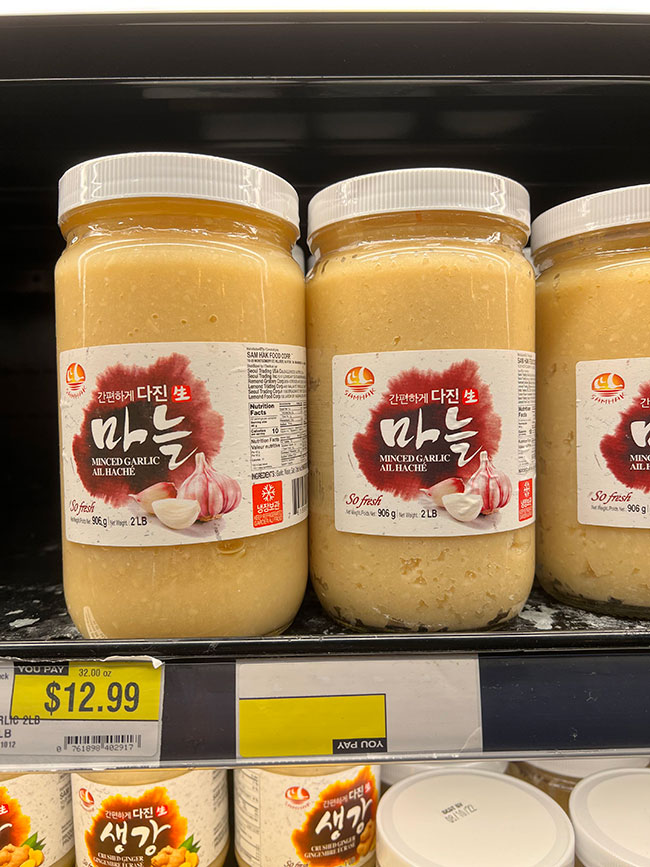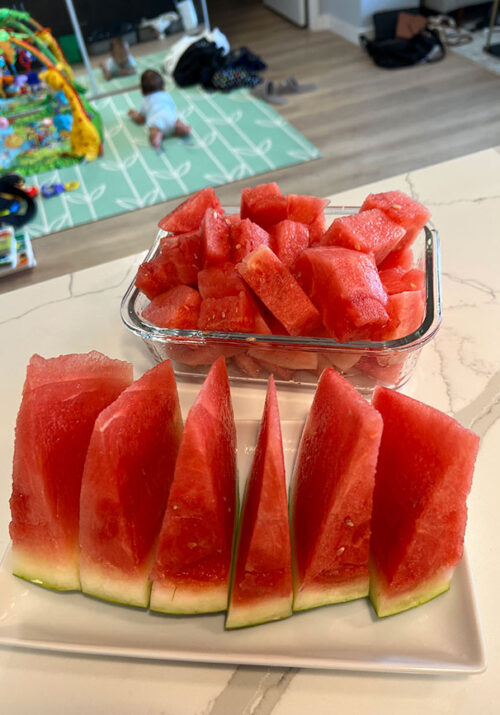
Hey guys! It’s Chef Chris Cho and as I’ve always said, my ultimate goal is to teach you guys how to cook. More so, I want you guys to learn how to cook Korean food in the simplest way possible. Here are 20 pantry essentials you need to have in your kitchen so you can jumpstart your cooking journey and start falling in love with Korean food!! Yeobosayo!
Most of these ingredients are available at Hmart, Asian grocery stores, or Amazon. You know I gotchu so I have them linked here and also in each recipe post. Let’s go!
Disclaimer: I get a small commission at no additional cost to you when you make a qualified purchase under the affiliate links.
Minced Garlic

Garlic is an aromatic that we use in almost every dish. I like having this around because it saves me a lot of time peeling garlic. You can go about it two ways: You can buy a jar similar to the photo above, or you can buy fresh garlic, peel it, and throw it in the food processor to mince. Check this video for storage instructions! Almost all my recipes have a tablespoon of garlic because it just makes everything tastier!
Minced Ginger

Similar to garlic, ginger is also an aromatic that I use in many dishes. And like garlic, I like having this around so I don’t have to peel and chop it every time. Ginger is a pantry essential because it provides soups and stews a refreshing spicy taste that helps with coughs and colds. I also use ginger to reduce the strong smell of meats such as beef, lamb, and seafood. Some recipes that use minced ginger are Soy Garlic Chicken BBQ, Spicy Chicken BBQ, or Korean Dumplings.
Sesame Seeds

Sesame Seeds have different varieties in supermarkets. There are raw, toasted, and black sesame seeds. When you get raw sesame seeds, you can easily toast them over low heat, stirring occasionally until golden and fragrant. For toasted sesame seeds, it is usually more expensive but is ready to use. I often use white toasted sesame seeds for garnish in almost all my recipes!
Sesame seeds leave a nutty flavor to stir-fries, stews, and braised dishes and an additional texture when used in side dishes like Spicy Cucumber Banchan, Burdock Root, and Spicy Radish Salad. Some people have allergies to sesame seeds, so it is okay to leave this out in recipes.
Dried Seaweed

Dried Seaweed or Miyeok is a common main ingredient in many Korean dishes. To use this, you need to soak the dried leaves in cold water for 20 minutes and you will see them expand! The seaweed yields a lot so one bag can turn to different recipes! Great for broke boyz!!!
Some delicious seaweed recipes include Sweet & Sour Salad and Seaweed Soup. Both are very nutritious, especially for pregnant women. They typically eat these during recovery after giving birth, thus the reason why Koreans drink the soup on their birthdays is to honor their moms for everything they’ve done for them. Dried seaweed is a pantry essential for me because it has many uses, it is healthy, and it is very symbolic.
Seaweed Laver

Seaweed Laver comes in two kinds: Jaerae Gim and Kimbap Gim. Jaerae Gim is thin, glossy, brittle sheets, seasoned, and ready to be consumed. They are used as a side dish in rice meals, toppings for soups, or can be crushed and rolled in dishes like Jumeok-bap!
Another variety of seaweed is the Kimbap Gim aka Nori Sheets. It comes in bond paper size sheets, thicker, more flexible, and unseasoned which are usually used in Kimbap, California Roll, or other sushi rolls. Seaweed brings a fresh ocean taste to any dish it is used in. When you have leftovers, place them in resealable containers and keep them in the dark.
Dashima or Dried Kelp

Dashima, also called Kombu in Japanese, is basically dried kelp. It usually comes in thick, huge, dried sheets and has a white powdery substance on top. In Asian cuisine, we boil this for several minutes to make dashi stock for our soup base. Just like what I did in Dried Pollack Bean Sprout Soup and White Soondubu!
Dashima is an essential pantry item because it brings natural umami and depth of flavor so you can use less salt, MSG, and meat-based bullion. You know that feeling when you drink soup and you feel relief afterward?? The dashima broth nourishes the body because of the vitamins and minerals it contains! To store, place in a cool, dark, and dry place.
Dried Anchovy

Dried Anchovies come in three sizes: small, medium, and large. The small and medium anchovies are usually for sweet and spicy stir fry and then served as a side dish or snack. On the other hand, we use large anchovies as an ingredient to create soups or stew bases. Just like what I did in this Kalguksu recipe!
When you buy dried anchovies, you can store them in the freezer for a year. Before using, thaw it out, remove the head and gut, then boil it with dried shrimp and kelp for the base of the soup. Dried anchovies are high in calcium and protein, so it is naturally good for your health!
Dried Shiitake Mushroom

Dried Shiitake Mushrooms have a strong earthy flavor that is used as an additional ingredient to soups, stir-fried noodles, or braised meat—just like Soondubu Jjigae and Galbi Jjim! Not only does it give dishes a savory-umami flavor, but its texture can also be a meat replacement. Shiitake mushrooms are low in fat, and rich in fiber, minerals, and amino acids. Because of this, it has become a widely used ingredient in East Asian cuisine.
To prepare: rinse the dried mushrooms in cold water, then soak them in hot water for 20 minutes with a cover. Discard the stem and squeeze before slicing or adding to dishes, then use the soaking water as a vegetable stock. While you can also use a non-dried variant of Shiitake Mushrooms, I find the dried ones to have a stronger flavor and can last longer when stored in the fridge.
Dashida or Korean Instant Soup Stock

Dashida is a Korean instant soup stock that comes in either beef, anchovy, or clam flavors. In my recipes, I use this as a seasoning for soups, stews, stir-fries, and braised dishes. Since it is cultural for Koreans to have soup in any meal, dashida is an easy way to make them richer. You will only need a small amount as it already contains salt and MSG.
This is different from dashi powder. While both serve as an instant stock, dashi powder is mainly based on kelp, bonito, or mushroom and is usually MSG-free. To store, make sure to keep dashida in an airtight container inside the fridge.
Salted Fermented Shrimp

Saeujeot or Salted Fermented Shrimp is a common and versatile ingredient in any Asian kitchen. In fact, it comes in different varieties depending on where it came from. We often use this as a seasoning that provides a deep and complex flavor to dishes like kimchi, steamed eggs, and hangover soups. It can be funky and pungent, but it brings salty umami even in small amounts. Lock it tight (because it smells) and store it in the fridge after opening.
Doenjang or Korean Fermented Soybean Paste

Doenjang or Korean Fermented Soybean Paste is similar to miso because it comes from fermented soybeans. Despite the similarity, soybean paste is different because of the chunkier texture and more umami taste. It has a funky and pungent smell, but tastes super good!! The sour, salty, and rich paste is perfect for enhancing soups and stews.
Doenjang is the main ingredient of the classic Korean BBQ dip: ssamjang! I love this condiment so much that I created Soybean Paste Pork Belly, you might wanna check that out too! After opening, store the tub in the fridge.
Gochujang or Korean Red Pepper Paste

Gochujang or Korean Red Pepper Paste is probably the most common condiment in Korean kitchens. It is culture for Koreans to consume spicy food: Korean kids can easily eat spicy food and adults look for it the first thing they feel stressed. Spicy food is a comfort food for many of us.
Gochujang is a sweet, savory, and spicy paste. I used it in classic recipes such as Gochujang Jjigae, Bibimbap, Tteokbokki, General Cho Chicken, and many more. You only need a small amount of gochujang as it goes a long way. A combination of soy sauce, sesame oil, sugar, and garlic is the best complement for this spicy paste. Once opened, you can store the tub in the fridge.
Gochugaru or Korean Red Pepper Flakes

Gochugaru has many names: Korean chili flakes, Korean hot pepper flakes, and Korean chili powder. Either way, they are coarsely crushed sun-dried seedless peppers. I use gochugaru in two ways: In huge amounts, especially in Kimchi, because of its gentle heat. Or paired with gochujang and other spices, like what I did in this FIRE Enoki Mushrooms and Jeyuk Bokkeum. The pepper flakes elevate any dish by giving it sweetness, smokiness, spice, and a vibrant red-orange color. These are often sold in big bags, so for leftovers, you can store them in the freezer.
Soy Sauce

Soy Sauce is probably the most important liquid condiment in any Asian kitchen. In grocery aisles, the number of variants of soy sauce might get confusing. There is light, regular, dark, premium, sweet, low sodium, and so much more. When my recipe calls it, use light or regular soy sauce, unless I say use soy sauce for soup!
Soy sauce comes from fermented soybeans and adds a salty, umami taste to any dish. It can be a replacement for salt as seasoning for stir-fried dishes like soy garlic enoki mushrooms, chicken teriyaki, and Cantonese steamed fish.
You can also use soy sauce as a meat marinade for beef bulgogi or LA galbi or dipping sauce for onion side dishes, dumplings, or Korean pancakes. Any soy sauce-based dishes would have a vibrant caramelized color as a result. To store, place the bottle in the pantry at room temperature.
Fish Sauce

Fish Sauce is a thin, light amber-colored liquid condiment that comes from fermented fish or krill. This is great for clear soups, meat marinades, Asian salad dressings, and as a dipping sauce. Due to its versatility, it is a staple in East Asian and Southeast Asian cuisine.
Despite its funky and strong salty taste, fish sauce adds savory umami to dishes where it is used like Soybean Sprout Soup and Spicy Cucumber Salad. A little amount will go a long way and it can even be a replacement for salt. Store the bottle in the pantry at room temperature. If you see a salt formation in its cap, it’s normal, and can still be used.
Mirin

Mirin is a sweet rice wine that is made from fermented steamed glutinous rice and rice liquor. Many interchange mirin and sake. They are similar, but mirin has lower alcohol content and is used differently than sake.
It is often used for seasoning and glazing because of its syrupy consistency. Mirin enhances the taste by giving the dish sweetness, just like in Candied Sweet Potatoes and Spicy Dried Squid. Other uses for mirin include using it as a meat tenderizer, and as an agent that reduces the smell of fish and seafood. If you do not have this, you can easily replace it with sake + sugar.
Rice Vinegar

Rice Vinegar is a colorless to pale yellow liquid condiment that comes from fermented rice. Many people confuse rice vinegar with mirin. To differentiate, rice vinegar tends to be more acidic but not as sour and strong as distilled vinegar. Rice vinegar is used in sushi rice and other Asian salad dressings. Vinegar + sugar can be the closest substitute when you do not have rice vinegar at hand.
Maeshil or Korean Plum Extract

Maeshil or Korean Plum Extract is a syrup that is used as a fragrant sweetener. It isn’t a traditional Korean ingredient because it’s only been around for 10 years, but it has quickly become a staple since it’s a healthier option for sugar. However, plum syrup is not a complete replacement for sugar because it has sweet and sour notes.
Mix maeshil with tea or booze, as well as a marinade for meats, and a tasty ingredient for dishes such as Cold Cucumber Soup or Spicy Garlic Fried Chicken. It isn’t always accessible here in the US, so you can easily use sugar as its alternative. However, if you happen to get your hands on this, it’s worth trying!
Corn Syrup

Mulyeot or Korean Corn Syrup is a clear thin syrup that has been extracted from corn. In Korean cuisine, we commonly use this in small amounts to enhance the flavor and give a shiny glaze to any dish. At times, you can use corn syrup as a replacement for sugar and you can also use sugar and the syrup together. Just like in Fishcake Stir-fry or Korean Sausage Stir-fry!
Sesame Oil

Sesame Oil is oil derived from sesame seeds. There are actually two kinds: Non-toasted and toasted. Non-toasted sesame oil is light in color and used like any other cooking oil. On the other hand, toasted sesame oil is dark amber in color and has a nutty flavor and fragrance.
In my recipes, I use toasted sesame oil as a finishing touch in stir-fries, fried rice, sauces, and many more. You can use this in small amounts during the latter part of your cooking so it does not burn from the heat, otherwise, it might turn bitter. Sesame oil will balance out any strong taste from soy sauce or vinegar. Check out Steak Fried Rice and Galbi Fried Rice, try them and see how sesame oil makes the food so much better! To store, place in a cold, dry, and dark place once opened.
Found this helpful to jumpstart your Korean cooking journey? Test drive these pantry items using the recipes linked in this article! If you liked them, rate, comment, or tag me on my socials Chef Chris Cho on Facebook and Instagram and subscribe to my Youtube and Pinterest to be updated on future recipes!





Wow! I just found you on FB last night! I love how simple you make it to make your dishes! I was adopted from S Korea when I was 6 & raised in Jersey across from Philly & my Korean last name was also Cho. Thank you thank you for sharing all this & for your passion for teaching & sharing! You’re SUPER FUCKING AWESOME!!!!
Chris Yoboseyooo!! Thank you for your recipes. What kind of oil do you fry your chicken in and at what temperature?
You’re awesome!!
Can you show me how to make kemchi
Hello, I’m Diesha Harris from Mississippi. Im so in love with Korean food and the culture.
On that note, I really want to make kimchi but I’m allergic to fish. Is there a way I can make it without any fish producs?
Thanks for sharing your go to staples at least I hope these are your favorite brands!!! I’m always not sure what brands to buy when at the Asian grocery store there are soooo many options!
It can be overwhelming! But they are all essentially the same
Is there a brands of kimchi that you recommend and where can I buy it? I live in Michigan. Thank you!
Hi Don! Usually it’s trial and error with store-bought kimchi. Maybe you can check out Korean restaurants near you and ask them if they have some for sale! If they’re owned by Koreans, they would most likely be good!
I love watching your videos. I’ve been cooking this for about 3 weeks, now everyone says my meals are better than where they get take out. I think we are doing g a nice meal for Xmas this year. Keep it up..I LOVE LOVE LOVE IT.
Thank you so much! So happy to see everyone improve their cooking! Hope you had a great Christmas with the recipes!